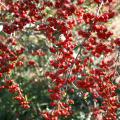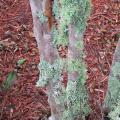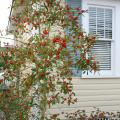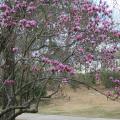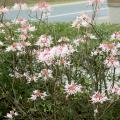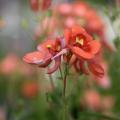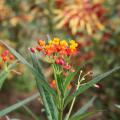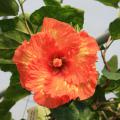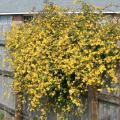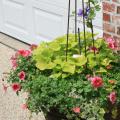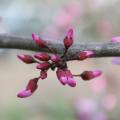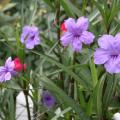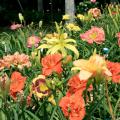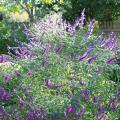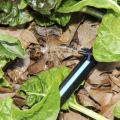Southern Gardening from 2013
Color in the landscape can seem like an unachievable goal in the cold and dreary winter months. But it can be reached when gardeners rely on plants with features other than flowers to brighten the areas around homes.
Pyracantha is one of the best choices the home gardener can make for the winter landscape. This plant’s colorful berries can add beauty and interest to any winter setting.
When funny, mold-looking things start growing on landscape trees and shrubs, phones start ringing in Mississippi State University Extension Service offices across the state.
Winter is a wonderful time of the year when many of our deciduous trees drop their leaves, signaling the end of one year with the promise of new growth in the spring. But it’s also the time when home gardeners start to notice other things growing in their gardens. The fact that they are green to gray in color adds a sense of dismay.
Much of the state got a dose of winter weather last week. Seeing pictures of gardens and landscapes farther north covered in a blanket of snow made me thankful for living on the coast. Having lived in colder climates, I had enough of snow before coming to Mississippi.
January and February are good times to see where landscapes need evergreen color to break out of the drab grays and browns of winter. When you find a spot that needs a pick-me-up, Savannah holly is a superb evergreen plant to grow in our Mississippi gardens and landscapes.
It has a natural pyramidal growth habit that is loose and open. This holly is versatile in the landscape and can be used for screening or strategically placed as single specimens.
Even though fall is the ideal time, it’s still not too late to plant nice trees into our Mississippi gardens and landscapes. Of course I can’t list every tree in this column, but I want to draw your attention to a few I’m sure you won’t be disappointed to have in your yard.
The first is the bald cypress. You may think it has to be planted in soggy locations, but this tree is very adaptable. Some of the best specimens I have seen were being grown in very high and dry locations such as islands in parking lots and planting wells in sidewalks.
Many Mississippians are anticipating the first signs of the spring show put on in our landscapes by the popular, but nonnative Southern Indica azaleas. These shrubs hide behind their evergreen foliage, waiting to dazzle us with color.
Some gardeners consider native azaleas hard to grow, so we don’t see these varieties as much in Mississippi landscapes. Several species of native azaleas thrive in the Southeast. They may not be as showy as their evergreen cousins, but native azaleas are stunning in their own right.
Cabin fever seems to hit me earlier each year, and it doesn’t help that we haven’t had much of a winter the past couple of years.
I already have tomato transplants ready to put in the ground even though it’s still two months from the traditional last frost date here on the coast. I saw blooming annuals for sale this weekend at a local garden center. I think I’m feeling a little warm.
I think all gardeners love to see butterflies visit their gardens in the summer months. If you want more butterflies this year, start planning now what to plant this spring to attract them.
I want to tell you about two of my favorite plants that are guaranteed to attract these garden visitors.
Several years ago, a new group of tropical hibiscus exploded onto the market with vibrant and exciting colors -- a Technicolor dream.
Thirty-eight fantastic selections of Cajun hibiscus, bred and released by the Dupont Nursery in Louisiana, feature colors ranging from bright yellows to pinks, reds and whites. Some of the more spectacular blossoms are those with color blends and those with bright red eyes.
According to the calendar, we are just a few days away from the official start of the spring season. But if you have been watching the garden and landscape like I have, you’ve seen signs of spring for at least several weeks. The plants are starting to wake up.
Yellow jasmine is one of the most reliable early signs of spring and is native all over the Southeast. While you’re driving along the roads and highways in Mississippi, you can see yellow jasmine showing off its vivid blooms.
Every spring the home gardener is bombarded with new and improved petunias for the garden and landscape, making it hard to decide which to bring home from the garden center. In my opinion, you simply can’t go wrong selecting any of the Supertunias.
For the past several years, I have been watching and writing about these fantastic garden performers. Whether used as spreading plants in the landscape or as container and hanging basket plants, supertunias have been good performers in Mississippi.
Mississippi has many flowering native trees, and one that gets its fair share of attention this time of year is the redbud. These trees flower early in the spring before most other trees have started to leaf out after their winter naps.
Although most flowering trees native to Mississippi tend to be understory trees that can be hidden by bigger trees and their foliage, it’s common around the state to see a redbud framed or silhouetted by leafless hardwoods.
The story you are about to read is true. Only the names have been changed to protect the innocent.
It was a spring morning several years ago just like this morning when I received the call. I thought it was going to be like many others I receive. I was wrong.
The person on the other end of the phone had a neighbor’s cousin to visit the coast some years ago but wasn’t sure about the season. While at a local golf course, they had spotted a blue azalea, and now the caller wanted one.
One of the flowering plants I remember from my youth is the cleome. I loved these tall plants with flowers I thought looked a little spidery.
Many years later, when I rediscovered cleome growing in my neighbor’s yard, I reached out for a closer look at the flowers and was suddenly reminded of the one aspect I did not like about these plants. I had forgotten about the thorns and had impaled my thumb.
With spring in the air and our landscapes waking up from their long winter’s nap, Mississippi gardeners jump into the many chores needed to get gardens off to the right start.
One of the first decisions to be made is what to plant. We flock to garden centers looking for inspiration and new plants to enjoy in the coming year. Sometimes we forget to look in our own gardens for the options we already have.
Has the search for blue flowers left you feeling blue?
Mississippi has a long tradition of being famous for blues music. In fact, the Mississippi Blues Trail has markers all across the state telling the story of the blues.
Mississippi gardeners also have a long tradition of wanting blue flowers for their gardens and landscapes. Blue is a coveted color in the landscape, and plant and seed catalogs try every year to meet the need for the color blue.
Like many home gardeners, I used to put plants in my landscape without worrying about labels because I was sure I’d remember what was planted where. And like most of you, I would end up scratching my head wondering what I had planted where.
One of the best gardening tips I can share, especially in the spring when you’re putting so many new things out, is to label your landscape plants.
If we ever move into the warmer – even hotter – summer season, I’m looking forward to the prolific flowering of calibrachoa. These plants are commonly known as “million bells,” which is a good description because it seems these plants have a million flowers.
Many selections of million bells are sold under different series names, and they seem to come in every color of the rainbow. One of the best qualities of these plants is that they are self-cleaning, so deadheading in not required.
Many gardeners try to give their landscape the feel of an informal cottage garden. This garden concept has a loose, flowing feel, kind of like you just let plants grow wherever they happen to pop up in the landscape.
I had a professor way back in college who had a unique cottage garden planting method: He would walk through the landscape and just toss plants over his shoulder. We planted them where they landed. And you know what? His gardens looked awfully good.
Although many Mississippi gardeners are wondering if it will ever quit raining and let their landscapes dry out a bit, now is actually a good time to think ahead to the inevitable hot and dry weather of summer.
Dry conditions create problems for our home gardens and landscapes, and gardeners water their lawns and landscape beds a lot more than usual during these times.

